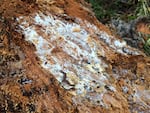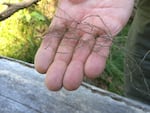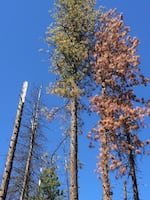Producer: Vince Patton
Videographer/Editor: Todd Sonflieth
Videographer: Nick Fisher
Animations: Aaron Drake Wintersong, Todd Sonflieth
______________________
Let's begin with a couple of riddles.
What's bigger than a whale, yet hides out of sight? What could fill 250 semitrucks, yet spreads itself thin?
The answer lies in the Blue Mountains of Eastern Oregon and it tries to kill whatever it touches.
But to see it, you have to know what to look for.
It's a fungus.

The honey mushroom derives its common name from the amber colored fruit that emerges in the fall.
Nick Fisher / OPB
"People don't think of mushrooms killing trees," said Greg Filip, a pathologist with the
.
Trees often benefit from mushrooms at their roots. Honey mushrooms, however, suck the life out of a number of types of trees.
The trees fight back, shoving out the invading fungus, oozing out of holes in the bark.
It's probably a lost cause.
"It's girdled by the fungus," Filip said. "The fungus will grow all the way around the base of the tree and then kills all the tissues."
Filip stands in the Malheur National Forest surrounded by trees dying in slow motion.
"It could be 20, 30, 50 years maybe before it finally dies," he said.
If you're thinking of a classic mushroom with a cap and gills and spores, the honey mushroom fits that bill for only a few weeks each autumn.
Most of the year it's just a thin, white layer that packs a lethal punch.

The fungus grows under the bark of trees.
Vince Patton / OPB
Filip chops at the base of a tree with a hand axe, moving higher and higher up to remove the bark. Even two feet above the roots, he finds a layer of the white fungus.
His fingers peel back a layer that feels "like latex paint."
That white fungus spreads up under the tree's bark and rots its roots.
"Then there's no movement of water or nutrients up and down the tree when that happens," he said.
Back in 1988, Greg Whipple was the first Forest Service employee to realize they had "something different" on their hands. Back then, it seemed to cover 400 acres.
As of this story, it's footprint covers more than 3 square miles.
"We haven't seen anything else in the literature that would suggest that anything else in the world is larger in acreage," Filip said.

When it fruits in the fall, the fungus can shove several layers of bark out of the way.
Nick Fisher / OPB
They've dug out samples far and wide, and in every spot they find more fungus.
It's not just the same type of fungus. DNA testing has convinced the scientists this is the largest single living organism in the world.
If you scooped it all up and piled it together, scientists calculate it could weigh at least 7,500 tons and maybe up to 35,000 tons.
That's the weight of more than 200 gray whales.
This humongous fungus is nothing new.
"When you realize this fungus spreads at one to three feet a year and you have something that large, you can calculate the age," Filip said. "And we're looking at something anywhere from 2,000-to-8,000 years old.
The fungi's scientific name is Armillaria.
It also has a couple common nicknames, including "honey mushroom" and "shoestring fungus."

The fungus takes a "shoestring" form as it spreads along tree roots underground.
Vince Patton / OPB
The shoestring name refers to this fungi's unique ability to take an entirely different form as it spreads through the forest.
Instead of white, rubbery layers, it sends out black fibers underground. The trees' interconnected roots provide an unwitting pathway for this parasite on the prowl.
The honey mushroom exists in other places like Michigan and Germany. But Oregon's is the largest ever measured.
Near Glenwood, Washington, the fungus has plagued private timber harvesters for decades.
In the 1970s, researchers set out to see if they could eliminate the fungus entirely on test plots at a private timber farm.
In some areas, they cut trees and dug out stumps.
In others, they went farther and raked out every last fibrous root they could find. This produced the best results with less fungus and more pine trees survived after being planted on this treated ground. The study has continued for more than 40 years.
Dan Omdal, with the Washington Department of Natural Resources, said there's one significant drawback to the most effective approach. "It's very expensive and oftentimes prohibitive to do that level of intervention."
Timber companies can't afford to dig out every last trace of the fungus.
Omdal is trying another approach. Perhaps they can find which kind of trees can best manage to live with the fungus.
On DNR land near Glenwood, they deliberately planted four different kinds of conifers inches from the stump of a tree killed by Armillari.
Of the ponderosa pine, Doug fir, western larch and white pine, perhaps one can tolerate the fungus without dying.
"Remember, it's the baddest fungus on the block," Omdal said. "We're looking for a tree that can grow in its presence. It's foolish to plant the same species where you harvested in areas that are infested by the disease."
In Eastern Oregon, Filip notes there's another way to view the humongous fungus.
It's simply nature helping nature. It kills trees, rots them and recycles them back into the soil.
"There's a wildlife benefit to these trees," he said. "Once they're dead, they decay, the birds begin to excavate them and use them for cavities."
Living on such a scale, under entire forests, scientists say the humongous fungus is not something humans will have much impact on.
It's part of the landscape.










